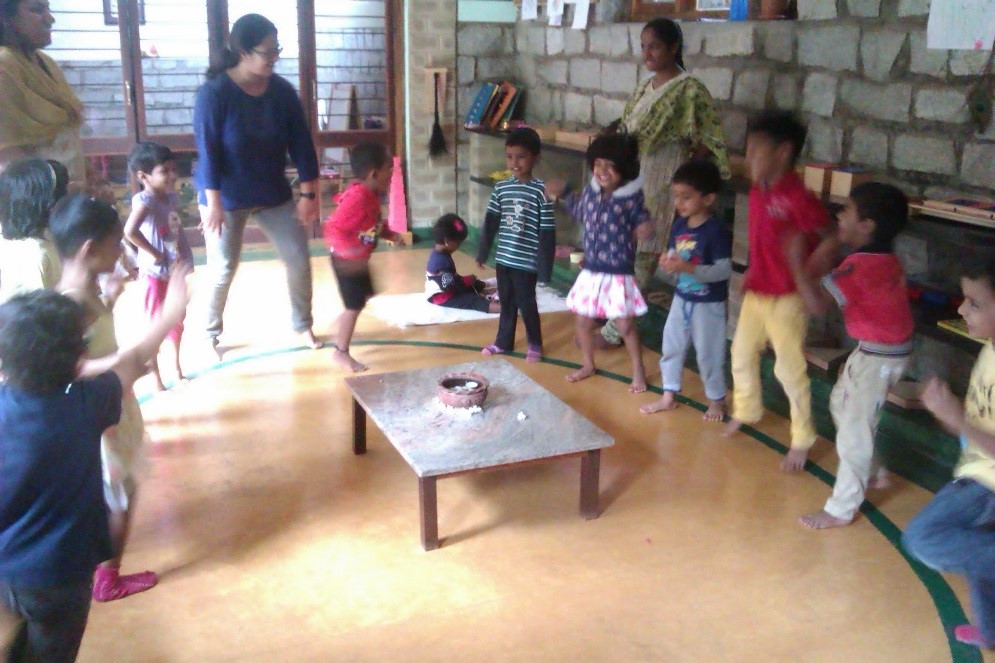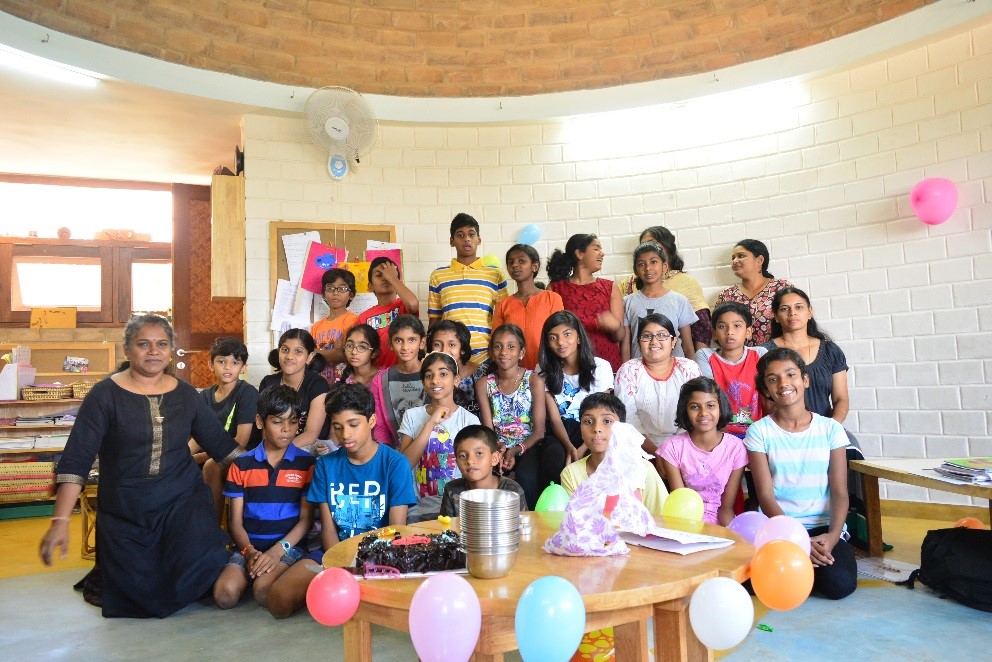The ‘Creative School’ is located in north Bengaluru, and aims to inspire and encourage children to become abundant and conscious creators of their own lives. By providing an environment for holistic development of the child, the school runs on a strong spiritual science foundation.
In an interview with Ms. Jayashree Ashok, Founder Director, and Ms. Rathy Nair, founding team member and primary school coordinator, a lot of in-depth information was acquired on the functioning of this unique school.
What inspired you to start Creative School?
To start with, my husband Ashok and I lived in Seattle, USA, and worked for Microsoft. In 1994, the both of us felt like giving back to the society; giving back to India. For that, we opened an organisation called ‘Asha’ to help set up schools in villages in India. This was what started our journey. We helped set up schools from scratch, in India and we were financially supporting them. This brought me here many times and I got to meet many amazing educationists who were looking at education very differently. Interacting with them, I realised that schooling and education that I had experienced was very small from what the potential of education could be. Few of the people I met introduced me to the writings of Sri Aurobindo and The Mother on integral education.
Later, in 1999, I decided to quit my job in Microsoft and spend 3-6 months in India, doing field work. My husband and I took turns to come here. We gradually set up a village school in Tamil Nadu. This whole experience was very joyful for us than our corporate careers. The school work took us to different villages where we saw difficult circumstances. For us, it was two different worlds; one was where we had seen people coming from well-off background and comfortable families and the other was where people struggled for two meals a day.
This started my own transformation. I asked myself many questions. I realised that the problems that usually come are not ‘engineering’ or ‘subject’ related, but people related. For this, none of us are trained enough. I also realised that the education my friends in the US received, was completely different. They could fix doors, develop their hobbies and were very creative. People of Indian origin were doing well everywhere, technically. But when looked at holistically, they were not that great. To understand this better, I started studying a lot of schools in the Seattle area and volunteered in 2 schools. Out of interest, I started training in conflict resolution and mindfulness and became very good at emotional healing.
After this, my husband and I decided to come back to India for good. Later, people started coming to me for help and it spread through the word of mouth. I worked with high school children to help them release their negative emotions from failure, lack of confidence and so on. It helped a lot of children. With the guidance of Sri Aurobindo and The Mother, I open a full-fledged school with my knowledge on a ‘whole child’. With all that I had learnt and understood about education, I did not want my children to attend a main stream school. At that time, Reshma, the Principal of this school, Rathy and others came in and they stayed on. Before we knew it, 12 families came together we started the Creative School.
What is different, or, what is taught differently in Creative?
Schooling takes away the child’s natural connection from himself/herself. Children do not have to be taught but, they need to be guided to retain whatever they have. Our aim or idea was to start a school that will work on the principle of ‘whole child’, so that the child does not disconnect from himself/herself during the educational process. In our school, through different ages, we bring up emotional intelligence in many ways and show children various ways in which they can handle themselves. We also counsel parents, motivating them to let the children do what they love. We believe that when you love what you do, you will always find a way to move forward.
In Creative, we work differently with each age group. We have a 2-year grouping system. Children who are around the same ages are grouped together. For the youngest set of kids, we work in a way that is appropriate for them. Curricular work is in an age appropriate manner. Apart from this they learn breathing exercises, simple meditation, etc., in a child friendly way. We even teach them about the 5 elements – water, earth, fire, air, and space and how to balance them.

For the primary years, the main focus is to see that the child is very well established and is very confident with himself/herself. Academics naturally falls into place. Speaking of curriculum as such, we have an integrated approach and have taken the best of curriculum and practices from around the world. We also follow the IG framework.
We do have conventional subjects like math, science and languages and they are also taught in an integrated manner through project work. Children are also taught to create their own insights and intuition around mathematics.
One of the major things that is taught is that there are many approaches to solve a problem. Some children might want to express their answers through art and drawings while some might prefer writing and poetry.
Not one minute is wasted in school. We have lots of games in the process of learning. We include everything from clay to music, dance, theatre and sports. By the time children reach class 9 and class 10, they are so self-directed and tuned-in for their exams that we rarely have to nag them to study.
The Campus
The school is built with mud blocks and the whole school is powered by solar energy. Health and balanced eating is taught, by providing the children with organic food items straight from the farms.
Every waste item from the school is recycled. The kitchen waste is converted to biogas and compost for the garden. Through all these practices valuable lessons like recycling, sustainable energy, etc. is taught.

What are the ‘Life and Living classes’ and ‘Play Healing Centre’ in your school?
In the Life and Living class, we all sit and talk about different things that happen in class. Conflicts that come up in class are addressed, children learn about feelings, self-awareness, and learn to hear different perspectives from others. This environment is maintained throughout. So, they grow up with healthy respect for who they are and understand that the respect has to be mutual.
Play Healing is something that I learnt from a doctor in the US. In this method, it is through play and art that a child’s internal problems (if any) are worked out. Most of the times, children’s misbehaviour is out of some underlying social or emotional cause. This method involves puppets, clay, props and art. We help recreate scenarios that may have caused the child to be caught up emotionally. So, we help them to gently and easily release it. We give them an outlet, by addressing the root cause.
This method involves puppets, clay, props and art. We help recreate scenarios that may have caused the child to be caught up emotionally. So, we help them to gently release it. We give them an outlet, by addressing the root cause.
On regular intervals, children in groups of 4 and 6 are taken to the room and given the freedom to explore and create their own play. In this process, a lot of internal things gets worked out for them.
How easy or difficult was it for you to find teachers?
When we came back to India and decided to start a school, there were many people who told us that there was no way we could start a school, and no way we could find teachers. But that was not true at all! There are many teachers who are willing to join us. Something about the ‘whole child’ attracted people.
We follow a different way of teaching. To be able to support this kind of place and teachings, it is very important for the teachers to live it. It is very important for the teachers and parents to be who they want their children to be. For that, we have a rigorous teacher training process, out of which close to 30 courses are for the teachers to develop themselves. This is because we have not received this kind of schooling and it is very important to decondition ourselves. After the completion of these courses, it gives me pleasure to see teachers transform from, “Oh, I am a teacher” to “Yes! I am a teacher!”.
Teaching is such a sacred profession! It has a lot of self-respect. To teach, teachers need to honour themselves first. Only then can they honour the children they teach. For me, every one of my teachers is a gem. Each one is unique and has his/her own talent, and together we co-create this space. We have also kept the environment here such that it brings out the best in teachers. We also believe that when the teacher is well, the child is well. We, here, are making an honest attempt to bring back the sacredness in teaching. I am purposely using the word ‘sacred’ because I think it is important; important to bring back the concept that educating a child is sacred.
Watch Ms. Jayashree Ashok speak of how and why teaching is a sacred profession, here

